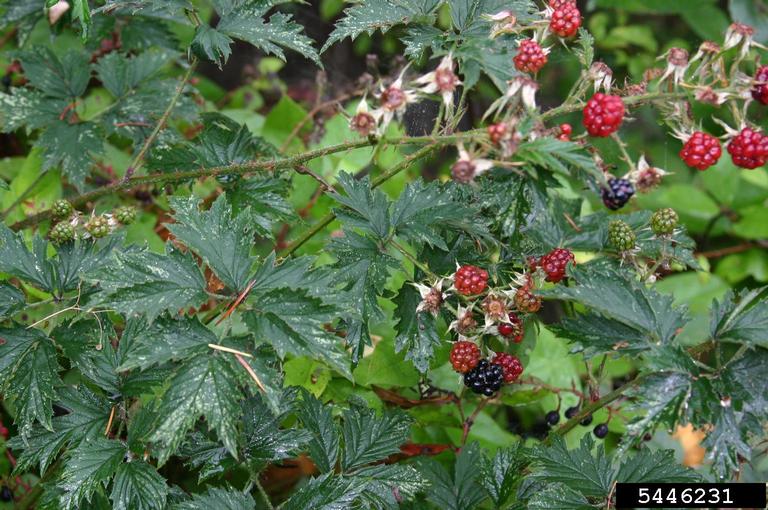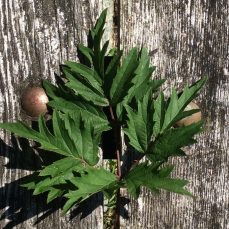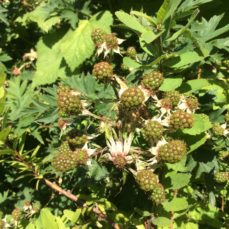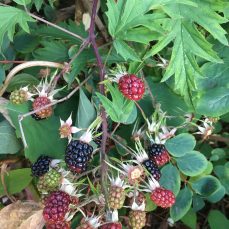
Photo credit: Leslie J. Mehrhoff, University of Connecticut, Bugwood.org
ID Characteristics
Cutleaf evergreen blackberry is an evergreen shrub belonging to the rose family.
Flowers: Occur in clusters of 5 to 20. Each flower has 5 petals and 5 sepals, is 3-lobed and is white to dark pink.
Stems: Upright to arched; canes are angled, branched and have curved prickles. Canes are biennial and can root along the stems and tips. Cutleaf evergreen blackberry shrubs can be up to 4 m tall, with individual canes reaching up to 10 m long.
Leaves: These are medium to dark green, composed of 5 leaflets that are deeply divided and look lobed with toothy margins. The leaves have hairy undersides.
Fruit: The shiny drupelets (blackberries) ripen in mid-late summer. The berries are 1 – 1.5 cm long.
Roots: Large, deep woody root ball that can exceed 10 m in length and 1 m in depth.
Similar Species
Native:
Trailing blackberry (Rubus ursinus) is the only native blackberry to British Columbia. It is a low, trailing plant with leaves divided into 3 distinct leaflets that are 15 cm long, dark green on both sides and toothed. Flowers are white or pink and are 2.5 cm wide. Trailing blackberry produces small blackberries and grows in disturbed sites and dry, open forests at low to mid-elevations, making them prevalent on Vancouver Island and the Lower Mainland.

Native Trailing Blackberry (Rubus ursinus)
Invasive:
Himalayan blackberry (Rubus armeniacus) is invasive in British Columbia and can be found throughout the Sea to Sky Region. The stem is robust and stiff with large prickles which are either hooked or flattened; stems can reach 12 m in length and 3 m in height. Leaves are round with tapered edges and the flowers are white-pinkish with a 5-petal arrangement.

Invasive Himalayan Blackberry (Rubus armeniacus)
Common blackberry (Rubus allegheniensis) looks similar to Himalayan blackberry, but is slightly smaller, and has leaflets with lightly toothed rather than jagged edges.

Common Blackberry Berries – linkmdavis, iNaturalist
Habitat and Origin
Cutleaf evergreen blackberry originates from Europe and was brought to North America for fruit production.
This plant thrives in a wide range of habitats such as disturbed areas, pastures, forest plantations, roadsides, riparian areas, riverbanks and wetlands. It prefers moist to wet areas in the lowland zone.
How it Spreads
Cutleaf evergreen blackberry can reproduce both by seed and vegetatively. Flowers can either self-pollinate or be pollinated, allowing the plant to reproduce by seed. The plant can also reproduce vegetatively by sprouting root buds and root developments on canes.
Cutleaf evergreen blackberry spreads vegetatively by rooting from the cane tips touching the ground or from nodes along the cane. Its seeds spread due to birds and mammals eating the fruit and dispersing them to new locations after passing through their digestive tract.
Impacts
Ecological:
- Outcompetes native plants
- Reduces biodiversity
- Can hinder the growth of shade-intolerant tree species
- Infests stream channels and banks
- Restricts the access of wildlife to water bodies
- Degrades pastures
- Increases likelihood of erosion along banks
Economic:
- Reduces land value
- Limits recreational access to water bodies
- Reduces sight lines along infrastructure
Stop the Spread
Cutleaf evergreen blackberry is abundant in certain portions of the Sea to Sky region but has not yet infested all potential habitats. The goal is to contain the spread of cutleaf evergreen blackberry to Squamish and the south (ISMA 1).
Help us contain cutleaf evergreen blackberry by reporting sightings on our website.
DO:
- Regularly monitor properties for weed infestations.
- Ensure soil and gravel are uncontaminated before transport.
- Check wildflower mixes to ensure that they do not contain cutleaf evergreen blackberry.
DO NOT:
- Unload, park or store equipment or vehicles in infested areas; remove plant material from any equipment, vehicles or clothing used in such areas and wash equipment and vehicles at designated cleaning sites before leaving infested areas.
- Plant cutleaf evergreen blackberry in a garden, no matter how well-contained its enclosure may seem.
- Move soil that has been contaminated with cutleaf evergreen blackberry.
- Compost any of the invasive blackberry species, especially the berries!
Control
Because of its food value, SSISC’s only uses mechanical methods to control invasive cutleaf evergreen blackberry, except at a handful of special case sites, which are not accessible to the public.
Mechanical Control
Repeated cutting and mowing can keep plants from over-taking, however cutting followed immediately by root removal is most effective. Pulling canes out of the ground before berry production also helps to control infestations.
Chemical Control
- Treating infestations with glysophate in the fall while canes are actively growing, after berries have formed and before the first frost, has proven an effective chemical control method.
- Triclopyr, 2,4-D and metsulfron are also effective forms of chemical control.
- We recommend that any herbicide application is carried out by a person holding a valid BC Pesticide Applicator Certificate. Before selecting and applying herbicides, you must review and follow herbicide labels and application rates; municipal, regional, provincial and federal laws and regulations; species-specific treatment recommendations, and site-specific goals and objectives.
Biological Control
Long-term grazing by goats has been proven effective, and chickens can be used to decrease the seed bank.
Sea to Sky Distribution
Cutleaf Evergreen Blackberry Factsheet
References
- Electronic Atlas of the Flora of British Columbia, Rubus laciniatus
- Fraser Valley Invasive Species Society, Evergreen Blackberry
- King County Noxious Weed Control Board, Best Management Practices for Himalayan Blackberry (Rubus armeniacus, syn. Rubus discolor) and Evergreen Blackberry (Rubus laciniatus)
- King County Noxious Weed Control Board, Evergreen Blackberry Identification and Control
- iNaturalist, Cutleaf Blackberry
- Simon Fraser University, Blackberry, Trailing
- United States Department of Agriculture Fire Effects Information System, Rubus laciniatus
- Washington State Noxious Weed Control Board, Evergreen Blackberry











